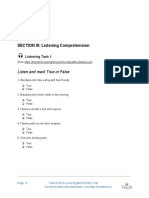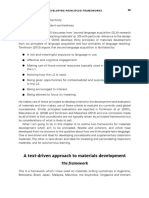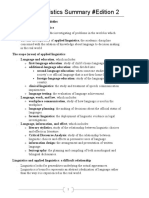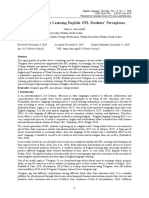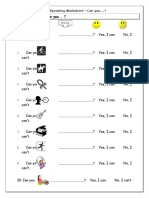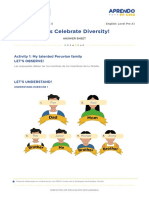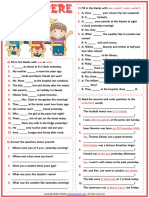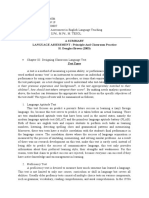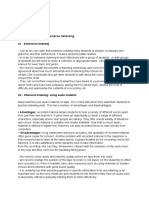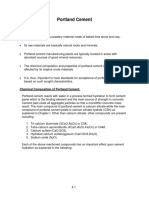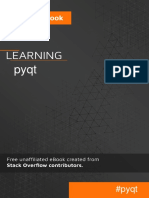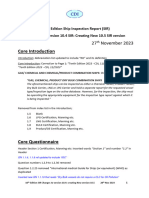Being A Good Citizen Unit Plan 1
Being A Good Citizen Unit Plan 1
Uploaded by
api-267509940Copyright:
Available Formats
Being A Good Citizen Unit Plan 1
Being A Good Citizen Unit Plan 1
Uploaded by
api-267509940Original Title
Copyright
Available Formats
Share this document
Did you find this document useful?
Is this content inappropriate?
Copyright:
Available Formats
Being A Good Citizen Unit Plan 1
Being A Good Citizen Unit Plan 1
Uploaded by
api-267509940Copyright:
Available Formats
1
2
Table of Contents
I. Block plan.2
II. Outline of the unit plan.3-4
III. Daily lessons
a. Lesson 1- Being a Good Classroom Citizen.5-6
b. Lesson 2- What is a Bad Classroom Citizen (Bullying).7-8
c. Lesson 3- How to be a Good Citizen in the Community...9-10
d. Lesson 4- Being a Good American Citizen.11-12
e. Lesson 5- Making the World a Better Place.13-14
IV. Appendix
a. Good Citizen Packet15-27
b. Bucket filler awards..28
c. Citizen Certificate...29
d. Scholastic News- How to be a Good Citizen.30
e. Voting ballot31
3
Monday Tuesday Wednesday Thursday Friday
Theme of the day:
How to be a good
classroom citizen.
Introduce unit
through bag activity
-define citizen: a
caring member of a
community
-discuss that even
first graders can be
good citizens
-move into HOW to
be a good citizen in
the classroom
Read aloud Manners
Mashup:
A goofy guide to
good behavior.
1
st
page of Good
Citizen packet
-write sentence and
illustrate
Scholastic News:
Read chorally
Good citizen video
https://www.youtub
e.com/watch?v=8O7
NoYtYX10
Theme of the day:
What is a bad
classroom citizen?
(Bullies)
Read the Billy Bully
story during story
hour that day.
-discuss what to do if
you or someone else
is bullied.
During the Social
Studies Instruction
Period
https://www.youtu
be.com/watch?v=8
O7NoYtYX10-
Begin with the
video to review
Read aloud How
Full is Your Bucket?
Instead of being
bullies we can be
Bucket filler
Go over bullying
policy
2nd page of Good
Citizen packet
-illustrate a bucket
filler and a bucket
dipper
McGruff Anti
Bullying Film-
https://www.youtu
be.com/watch?v=E
vhIdB_8WXE
Theme of the day:
Being a good citizen in
the community.
Google earth-
Neshannock
Define what a
community is.
https://www.youtube.c
om/watch/?v=jop2I5u2
F3U
Union is Strength
Read Aloud Do Unto
Otters: a book about
manners
By Laurie Keller
3rd page of Good
Citizen packet.
-illustrate the
community they live in
-write a sentence
about something they
do in their community
Theme of the day:
Being a good
American Citizen.
Read aloud Grace for
President
Talk about what
makes America
Unique
-freedom. voting
Introduce voting- lets
everyones voice be
heard
Vote on the most
important classroom
rules.
4th and 5th page of
citizen packet.
-American self
portrait
-Cut and paste
characteristics of
good and not good
citizens.
Theme of the Day:
Making the world a
better place.
Show the students the
globe- intro to taking
care of the world.
Read Our Class is Going
Green aloud.
Brainstorm how the
class can go green.
https://www.youtube.c
om/watch?v=8DJ45Yc3u
rg Going Green Video
Read Chorally: Making
the world a better place
Dear Mother Earth
Journal entry.
Plant something !
4
I. Introduction
a. Title: Being a Good Citizen
b. Grade Level: This unit is designed for Mrs. Contis first grade class at Memorial Elementary.
c. Duration: 5 days, 60 minutes per day.
II. Content
a. Goals
i. The students will improve problem solving skills through an exploration of scenarios.
ii. The students will become more aware of their role as a citizen in the classroom,
community, and country.
iii. The students will improve their listening and comprehension skills through the reading
and discussing of literature.
b. Concepts
i. Students will broaden their Social Studies vocabulary through the unique stories used
within the unit.
ii. The students will learn how to recognize and illustrate ways to be a good citizen.
c. Vocabulary
i. Citizen
ii. Community
iii. Democracy
d. Skills
i. Reading comprehension
ii. Reading Fluency
iii. Prediction
iv. Vocabulary
v. Writing
vi. Social
III. Objectives
a. Given teacher support, TSWBAT recognize and demonstrate what it means to be a good citizen
within the five day period.
b. Given the unit on Being a Good Citizen, TSWBAT inform others how to be a respectful,
courageous, and responsible citizen.
IV. Standards
a. CCSS.ELA-LITERACY.RL.1.1 Ask and answer questions about key details in a text.
b. CCSS.ELA-LITERACY.SL.1.6 Produce complete sentences when appropriate to task and
situation. (See grade 1 Language standards 1 and 3 here for specific expectations.)
c. CCSS.ELA-LITERACY.SL.1.1.B Build on others' talk in conversations by responding to the
comments of others through multiple exchanges.
d. CCSS.ELA-LITERACY.RF.1.4 Read with sufficient accuracy and fluency to support
comprehension.
e. CCSS.ELA-LITERACY.SL.1.5 Add drawings or other visual displays to descriptions when
appropriate to clarify ideas, thoughts, and feelings.
f. CCSS.ELA-LITERACY.RI.1.7Use the illustrations and details in a text to describe its key ideas.
g. CCSS.ELA-LITERACY.RL.1.3 Describe characters, settings, and major events in a story, using
key details.
h. CCSS.ELA-LITERACY.SL.1.1.A Follow agreed-upon rules for discussions (e.g., listening to
others with care, speaking one at a time about the topics and texts under discussion).
i. CCSS.ELA-LITERACY.W.1.2 Write informative/explanatory texts in which they name a topic,
supply some facts about the topic, and provide some sense of closure.
j. CCSS.ELA-LITERACY.W.1.8 With guidance and support from adults, recall information from
experiences or gather information from provided sources to answer a question.
5
k. CCSS.ELA-LITERACY.RF.1.4 Read with sufficient accuracy and fluency to support
comprehension.
V. Resources
a. www.dictionary.reference.come
i. Definition of vocabulary words
b. www.google.com
i. Used to find pictures/ images, inspiration for worksheets
c. http://www.educationworld.com/a_curr/curr008.shtml#second
i. Characteristics of a Good Citizen
d. www.teacherspayteacher.com
i. Citizen Certificate, clip art
e. www.bucketfillers101.com
i. Anti bullying and bucket filling worksheets
f. YouTube for the following videos:
i. https://www.youtube.com/watch?v=8O7NoYtYX10
ii. https://www.youtube.com/watch?v=EvhIdB_8WXE
iii. https://www.youtube.com/watch/?v=jop2I5u2F3U
iv. https://www.youtube.com/watch?v=8DJ45Yc3urg
g. Picture books
i. Manners Mashup: A goofy guide to good behavior.
ii. How full is your bucket?
iii. Do Unto Otters: a book about manners
iv. Grace for President
v. Our Class is Going Green
VI. Appendix
a. Good Citizen Packet (includes daily worksheets and extra pages for early finishers) 13 pages
b. Bucket filler awards
c. Citizen Certificate
d. Scholastic News- How to be a Good Citizen.
e. Voting ballot
6
Day 1
I. Topic: Defining what it means to be a good citizen.
a. Goal:
i. For the students to apply what they learn about being a good citizen to their daily lives in
the classroom.
b. Objectives: Given multiple modes of instruction, TSWBAT write a sentence with a capital letter
and an end mark describing how to be a good classroom citizen and illustrate their example.
c. Standards:
i. CCSS.ELA-LITERACY.RL.1.1 Ask and answer questions about key details in a text.
ii. CCSS.ELA-LITERACY.SL.1.6 Produce complete sentences when appropriate to task and
situation. (See grade 1 Language standards 1 and 3 here for specific expectations.)
iii. CCSS.ELA-LITERACY.SL.1.1.B Build on others' talk in conversations by responding to
the comments of others through multiple exchanges.
iv. CCSS.ELA-LITERACY.RF.1.4 Read with sufficient accuracy and fluency to support
comprehension.
II. Introduction- 15 minutes
a. Tell the students you are beginning a brand new unit today. Introduce the term citizen. Have
the students brain storm what the word citizen means. After sharing ideas tell the class that we
are going to be spending a little time each day learning how to be a good citizen! Emphasize no
matter how old you are you can be a good citizen. You are never too little! Show the class the bag
you have filled with things that illustrate being a good citizen. The bag will contain concrete
examples of ways to be a good citizen (following rules, recycling, sharing, etc) Have student
volunteers come up to the front of the classroom and pull items out of the bag and discuss their
significance in defining what it means to be a good citizen.
III. Development -15 minutes
a. Read the story Manners Mashup: A goofy guide to good behavior by Tedd Arnold. This story
will depict different ways to use manners and be a good citizen in school. As I read the story I
will hang up the different ways to be a good child citizen in a pocket chart.
b. Discuss how the students can be good first grade citizens.
c. Introduce the citizen certificate to the students. Explain if they demonstrate characteristics of
being a good citizen throughout the week they will earn a Good Citizen certificate.
IV. Guided/ Independent Practice- 10 minutes
a. First page of citizen packet. The students citizen packet will require the students to write a
sentence and illustrate a way they can be a good citizen in their classroom. Encourage creativity
and unique examples.
V. Closure- 12 minutes
i. Have the students open up their Scholastic News magazine titled I Spy a Good Citizen.
Allow students to read the magazine with a partner. Give the students a few minutes to
complete the back page of the magazine to explore the meaning of a community. The
magazine also requires students to follow a series of directions.
b. https://www.youtube.com/watch?v=8O7NoYtYX10- Good Citizen Rap- captures the main idea
of the whole unit. Hopefully by the end of the week the students will be singing along.
VI. Adaptations
a. More time: Play the song again encouraging the students to try and sing along.
b. Less time: Have the students finish the first page of their citizen packet for morning work the
next day.
c. Advanced learners: Journal entry- How can a first grader be a good citizen outside of the
classroom?
7
d. Learners who need additional support: Work in small groups to complete a graphic organizer-
Main idea thought bubble classroom citizen, supporting ideas branching off describing what
that looks like in the classroom. Use illustrations if needed.
e. High energy learners: Good citizen rap is intended to get the students up and moving. Story
requires a special helper to hang up main ideas into a pocket chart.
VII. Evaluation
a. Formative: The first page of the citizen packet will be collected and used to assess how well the
students were able to express what it means to be a good classroom citizen.
b. Summative: At the end of the unit the students will be assessed through a journal entry. The
students will write a letter to mother earth explaining how they plan to be a good citizen in the
future. At the end of the unit the students will also earn a citizenship award if they promise to
uphold the characteristics of a good citizen.
VIII. Reflection
a. Write and assessment of how the students performance and mastery in terms of each stated
objective?
b. Self-evaluation including an explanation for success or lack of it:
8
Day 2
I. Topic: Exploring what a bad classroom citizen looks like and the effects of bullying.
a. Goal:
i. For the students to be able to identify bullying and take the proper steps when they
notice someone being bullied.
b. Objectives: Given a story, and multiple examples, TSWBAT illustrate what both a bucket filler
and a bucket dipper look like.
c. Standards
i. CCSS.ELA-LITERACY.SL.1.5 Add drawings or other visual displays to descriptions when
appropriate to clarify ideas, thoughts, and feelings.
ii. CCSS.ELA-LITERACY.RL.1.1 Ask and answer questions about key details in a text.
iii. CCSS.ELA-LITERACY.RI.1.7Use the illustrations and details in a text to describe its key
ideas.
IX. Introduction- 15 minutes
** Billy Bully by Ana Galan will be read during story hour.
d. https://www.youtube.com/watch?v=8O7NoYtYX10- Begin the lesson with the good citizen rap.
e. Introduce that today we are going to be exploring what bad classroom citizens look like. (The
opposite of what we studied yesterday).
f. Read aloud to the students How Full is your Bucket by Tom Rath
g. Explain that bullies are bucket dippers.
i. Go over Neshannocks bullying policy and the steps the children should take if they see
someone being bullied or being a bucket dipper.
X. Development- 15 minutes
h. After reading the story brainstorm with the class ways to be both a bucket filler and a bucket
dipper. Make a chart of the students ideas.
i. Introduce the bucket filler awards you will be handing out to the students throughout the week
when you observe someone being a bucket filler. The students will also be able to fill out cards to
fill each others bucket. Explain that at the end of the week there will be a prize for the student
with the most bucket filler cards. The prize will be lunch in the classroom with the teacher.
i. Hand out a few bucket fillers to model what the cards should look/sound like.
XI. Guided/ Independent Practice- 15 minutes
j. Bucket filler activity page:
i. This page will require the students to illustrate what bucket fillers are and are not. Once
again encourage creative and unique examples.
ii. The students will illustrate a situation where someone is being a bucket dipper and
another example where someone is being a bucket filler.
XII. Closure 5 minutes
k. McGruff Anti Bullying Film- Provides a concrete example of what bullying can look like.
https://www.youtube.com/watch?v=EvhIdB_8WXE
XIII. Adaptations
l. More time: Have the students think of a compliment that would be a bucket filler to share with
the person sitting next to them.
m. Less time: Have the students finish the second page of their citizens packet for morning work
the next day.
n. Advanced learners: Bullying and bucket filler books are available on the top shelf of the book
shelf for early finishers to read. They can re-read a book we have read together or choose a new
book.
o. Learners who need additional support: Create a skit to provide a concrete example of what
bullying looks like and what should be done when a student sees someone being bullied.
9
p. High energy learners: Can be used as characters of the skit to get up and moving.
XIV. Evaluation
q. Formative: The second page of the citizen packet will be collected to assess how well the
students can identify bucket fillers and bucket dippers.
r. Summative: At the end of the unit the students will be assessed through a journal entry. The
students will write a letter to mother earth explaining how they plan to be a good citizen in the
future. At the end of the unit the students will also earn a citizenship award if they promise to
uphold the characteristics of a good citizen.
II. Reflection
a. Write and assessment of how the students performance and mastery in terms of each stated
objective?
b. Self-evaluation including an explanation for success or lack of it:
10
Day 3
I. Topic: How to be a good citizen in your local community.
a. Goal:
i. For the students to be able describe what a community is and explain ways to interact in
their community as a good citizen.
b. Objectives: Given a story and video example, TSWBAT illustrate the community he/she lives in
and write a sentence that describes something they do in their community.
c. Standards
i. CCSS.ELA-LITERACY.RL.1.1 Ask and answer questions about key details in a text.
ii. CCSS.ELA-LITERACY.SL.1.6 Produce complete sentences when appropriate to task and
situation. (See grade 1 Language standards 1 and 3 here for specific expectations.)
iii. CCSS.ELA-LITERACY.SL.1.5 Add drawings or other visual displays to descriptions when
appropriate to clarify ideas, thoughts, and feelings.
II. Introduction- 12 minutes
a. Explore and define what a community is. Use goggle maps to outline the community the
students live in. (Start by looking up Pearson Park, the school, the library, and then branch off
into a few other popular places in the area.) This will provide a visual of the students
community. Emphasize that in order for a community to be strong it needs all of its members to
work together.
b. Show the short video clip of animal communities working together. This is a silly example that
will show the students why it is important to stick together.
https://www.youtube.com/watch/?v=jop2I5u2F3U- Union is Strength
III. Development- 10 minutes
a. Read the story Do Unto Otters: a book about manners By Laurie Keller
b. This story illustrates what happens when someone new moves into the community. This will
help the students visualize what it means to be a member in a community and the characteristics
good community members exude.
IV. Guided/ Independent Practice- 15 minutes
a. Have the students complete the 3
rd
page of their citizenship packet. This page will have the
students illustrate one of their favorite places in the community and then describe with a
sentence how they can be a good citizen at that place.
V. Closure- 10 minutes
a. Allow each student to come to the front of the room and share their illustrations and ideas of
how to be a good citizen.
VI. Adaptations
a. More time: Listen to the citizen rap if there is time!
https://www.youtube.com/watch?v=8O7NoYtYX10- Good Citizen Rap
b. Less time: have the students finish the second page of their citizens packet for morning work
the next day.
c. Advanced learners: Have early finishers complete the good citizen Sort in the extra pages of
their packet. This will require the students to read scenario cards and sort them into piles that
represent both good and bad citizens.
d. Learners who need additional support: Provide students with a printed out map of the
community highlighting areas of importance to reinforce what a community is made of.
e. High energy learners: If you can tell your students need a brain break and to get some energy
out allow the students to get up and dance to the Good Citizen Rap.
VII. Evaluation
a. Formative: The third page of the Citizen packet will be collected and assessed to see how well
students can identify the community they live in and create ways to be a good citizen.
11
b. Summative: At the end of the unit the students will be assessed through a journal entry. The
students will write a letter to mother earth explaining how they plan to be a good citizen in the
future. At the end of the unit the students will also earn a citizenship award if they promise to
uphold the characteristics of a good citizen.
VIII. Reflection
a. Write and assessment of how the students performance and mastery in terms of each stated
objective?
b. Self-evaluation including an explanation for success or lack of it:
12
Day 4
I. Topic: What it means to be an American citizen.
a. Goal: For the students to be able to identify themselves as American citizens and to understand
the importance of being an American citizen.
b. Objectives: Given multiple means of instruction, TSWBAT to participate in an election and fill
out a ballot.
c. Standards:
i. CCSS.ELA-LITERACY.RL.1.3 Describe characters, settings, and major events in a story,
using key details.
ii. CCSS.ELA-LITERACY.SL.1.5 Add drawings or other visual displays to descriptions when
appropriate to clarify ideas, thoughts, and feelings.
iii. CCSS.ELA-LITERACY.SL.1.1.A Follow agreed-upon rules for discussions (e.g., listening
to others with care, speaking one at a time about the topics and texts under discussion).
II. Introduction 10 minutes
a. Bring up Google Earth and zoom out from the Neshannock community to the United States.
This will show the class the size of the country and the fifty states within the countries boarders.
Highlight some important US monuments such as the White House if time permits.
b. Read the story Grace for President by Kelley DiPucchio
i. This story illustrates a young girl running for class president. She faces many obstacles
through her election because she is a girl running against all boys for class president.
ii. Allow time for discussion after the story highlighting the importance of voting and
democracy.
III. Development- 15 minutes
a. Introduce what makes America special
i. Being a democracy, the right to vote, freedom of speech, etc
ii. Tell the students today we are going to be exercising our right to vote. Because
responsible citizens vote! Emphasize that voting lets every citizens voice be heard.
iii. Put up the poster of classroom rules on the board. Read each rule and discuss what they
mean and their importance in the classroom. Tell the class that today the students are
going to be filling out voting ballots voting on what they believe is the most important
classroom rule. Using privacy folders I will create a voting booth for the students and
vote at.
IV. Guided/ Independent Practice- 20 minutes
a. Today the students will complete a page in their packet that requires the students to draw their
American citizen self-portrait. This page is intended to help the student visualize themselves as
more than just a classroom citizen, because they are also American citizens.
b. Have the students complete the cut a paste worksheet that requires the students to cut out
characteristics and non-characteristics of good citizens. The students will sort the characteristics
under the titles Good Citizen and Not a Good Citizen.
V. Closure 5 minutes
a. Tally the votes and order the classroom rules according the students votes.
VI. Adaptations
a. More time: Have the students come to the front of the room and share their self-portrait with
the class.
b. Less time: Announce the results of the voting at the beginning of tomorrows lesson.
13
c. Advanced learners: Allow the students to complete one of the extra pages titled What a Good
Citizen Looks and Sounds Like. This will require the students to provide real life examples of
what good citizens do and say.
d. Learners who need additional support: Work in a small group with struggling learners to
complete the characteristic page. Defining each characteristic and discussing what it looks like
in the real world.
e. High energy learners: Allow the students to create short skits in groups of 3-4 to act out the
importance of each classroom rule.
VII. Evaluation
a. Formative: The fourth and fifth pages of the citizens packet will be collected and used to assess
how well the students can organize characteristics and non-characteristics of citizens.
b. Summative: At the end of the unit the students will be assessed through a journal entry. The
students will write a letter to mother earth explaining how they plan to be a good citizen in the
future. At the end of the unit the students will also earn a citizenship award if they promise to
uphold the characteristics of a good citizen.
VIII. Reflection
a. Write and assessment of how the students performance and mastery in terms of each stated
objective?
b. Self-evaluation including an explanation for success or lack of it:
14
Day 5
I. Topic: Learning how good citizens make the world a better place.
a. Goal: For students to be aware of different acts of service they can do to make the world a better
place.
b. Objectives: Given a five day unit about how to be a good citizen, TSWBAT write a letter to
mother earth explaining how the student pledges to be a good citizen in the future.
c. Standards
i. CCSS.ELA-LITERACY.W.1.2 Write informative/explanatory texts in which they name a
topic, supply some facts about the topic, and provide some sense of closure.
ii. CCSS.ELA-LITERACY.W.1.8 With guidance and support from adults, recall information
from experiences or gather information from provided sources to answer a question.
iii. CCSS.ELA-LITERACY.RL.1.1 Ask and answer questions about key details in a text.
iv. CCSS.ELA-LITERACY.RF.1.4 Read with sufficient accuracy and fluency to support
comprehension.
II. Introduction -15 minutes
a. Use Google Earth to show the students the whole earth. Ask the students if they know why it is
important.
b. Discuss what earth is and what it does for us.
c. Read Our Class is Going Green aloud.
d. Write Going Green on the board. Ask the students if they know what it means to go green.
Have the students recall examples from the story.
III. Development 20 minutes
a. Tell the students that going green can help take care of the earth. Talk about what it means to
go green. (Reduce, Reuse, Recycle)
b. Brain storm as a class ways to go green.
i. Reduce: take shorter showers, turn off lights
ii. Reuse: plastic bags when shopping
iii. Recycle: paper, card board, glass, plastic
c. https://www.youtube.com/watch?v=8DJ45Yc3urg Going Green Video- Great examples of
reduce, reuse, recycle.
d. Have the students read the leveled readers Making the World a Better Place- students will read
the story with partners or in small groups.
IV. Guided/ Independent Practice- 10 minutes
a. After reading both stories, one read aloud, one read together, the students will complete a
Journal Entry titled Dear mother earth. They will be writing to Mother Earth about how they
plan to be good citizens and take care of the world.
V. Closure 5 minutes
a. Have the students share some of their letters to mother earth. Possibly plant something in the
courtyard depending on the weather to demonstrate one way to take care of the earth.
VI. Adaptations
a. More time: Have the students work on the extra pages in their packet- word searches, color by
number, etc
b. Less time: Read the leveled reader Making the World a Better Place chorally to improve fluency.
c. Advanced learners: Early finishers can write more details in their journal entry. Students can
elaborate on ways they pledge to be a good citizen in the future.
d. Learners who need additional support: Provide struggling learners with sentence starts, such as
I promise to take care of the earth by..
15
e. High energy learners: Can be used as paper passers, story helpers, etc
VII. Evaluation
a. Summative: The 6
th
page of the Citizen packet will be collected at summative assessment. This
journal entry will assess how well the students synthesized the information from the five day
unit. The writing prompt will require the students to reflect on the past material in order to
write a pledge for the future.
VIII. Reflection
a. Write and assessment of how the students performance and mastery in terms of each stated
objective?
b. Self-evaluation including an explanation for success or lack of it:
16
17
I am a good classroom citizen when.
This is me being a good classroom citizen
18
19
20
21
This is my self-portrait.
22
23
24
25
26
27
28
Cut and sort into 2 piles! Good citizen and Bad Citizen.
29
30
31
32
33
You might also like
- Ucsb Admissions Decision LetterDocument1 pageUcsb Admissions Decision Letterapi-330184191No ratings yet
- The Foundations of Teaching English As A Foreign Language by Paul LennonDocument2 pagesThe Foundations of Teaching English As A Foreign Language by Paul LennonEda Can KarabalNo ratings yet
- Business Case Office 365 FinalDocument13 pagesBusiness Case Office 365 FinalbayoakacNo ratings yet
- Induction: Course ObjectivesDocument36 pagesInduction: Course ObjectivesQuyền Huỳnh TuấnNo ratings yet
- Multiple Intelligences in The Classroom Article by Jennifer NolenDocument3 pagesMultiple Intelligences in The Classroom Article by Jennifer Nolenapi-533624966No ratings yet
- Guide 1.1 - Describing People's Appearance and PersonalityDocument6 pagesGuide 1.1 - Describing People's Appearance and PersonalityMauricio RoaNo ratings yet
- Reflection Report - LTA - Bui Thu HienDocument33 pagesReflection Report - LTA - Bui Thu HienCrystal SkyNo ratings yet
- Task 5 BadnaswersDocument1 pageTask 5 BadnaswersDale CoulterNo ratings yet
- Olympus - Delta User ManualDocument124 pagesOlympus - Delta User ManualOscar PalacioNo ratings yet
- ANUAL - PCA - Ingles - 3ro BGUDocument33 pagesANUAL - PCA - Ingles - 3ro BGUPedro GuerreroNo ratings yet
- English Rubric Listening: Avasconezc@yahoo - EsDocument7 pagesEnglish Rubric Listening: Avasconezc@yahoo - EsAndrea PonceNo ratings yet
- Teens Club 2°medio 2016 WORKBOOKDocument38 pagesTeens Club 2°medio 2016 WORKBOOKKarina Ponce Rios100% (3)
- Programacion Ingles 2018Document74 pagesProgramacion Ingles 2018Anny Villanueva EspinozaNo ratings yet
- 55fbb8b0dd37d Productive SkillDocument6 pages55fbb8b0dd37d Productive SkilldewiNo ratings yet
- Lesson Plan Shopping ListDocument7 pagesLesson Plan Shopping ListArshinta KuswardhaniNo ratings yet
- Countable - Uncountable NounsDocument22 pagesCountable - Uncountable Nounsteuku aditiyaNo ratings yet
- Gabe l3 Unit 07 TestDocument4 pagesGabe l3 Unit 07 Testallein zeynaNo ratings yet
- A2 English Test ListeningDocument3 pagesA2 English Test ListeningAlejandraNo ratings yet
- A Text-Driven Approach To Materials Development: The FrameworkDocument12 pagesA Text-Driven Approach To Materials Development: The FrameworkVictorshuhrat KalandarovNo ratings yet
- Applied Linguistics Summary #Edition 2Document11 pagesApplied Linguistics Summary #Edition 2wed100% (1)
- House & Furniture - Prepositions of Place PDFDocument2 pagesHouse & Furniture - Prepositions of Place PDFesinNo ratings yet
- Pre-, While-, Post-Listening ActivitiesDocument5 pagesPre-, While-, Post-Listening ActivitiesАнна ДьячковаNo ratings yet
- Language Analysis ECRIF PDFDocument3 pagesLanguage Analysis ECRIF PDFileanamoramarin100% (1)
- Speaking RubricDocument1 pageSpeaking RubricAndreina MolinaNo ratings yet
- Combinepdf PDFDocument6 pagesCombinepdf PDFMariam BurhanNo ratings yet
- PCA - 2nd 3rd & 4th EGB ENGLISH PRE A1.1.2017-2Document22 pagesPCA - 2nd 3rd & 4th EGB ENGLISH PRE A1.1.2017-2Geraldine AlcivarNo ratings yet
- English Lesson Plan SampleDocument3 pagesEnglish Lesson Plan Sampleshah redzaNo ratings yet
- Language TestsDocument16 pagesLanguage TestsThu Anh NgôNo ratings yet
- Telegram App in Learning English: EFL Students' PerceptionsDocument12 pagesTelegram App in Learning English: EFL Students' Perceptionsnur colisNo ratings yet
- PCA Quinto InglesDocument17 pagesPCA Quinto InglesAntony BarraganNo ratings yet
- Importance of Teaching English PronunciationDocument3 pagesImportance of Teaching English PronunciationSayyed Abdullah Shah100% (9)
- Англ.яз 5-9 (на английском)Document87 pagesАнгл.яз 5-9 (на английском)Райхан АNo ratings yet
- Pca Ingles 5toDocument22 pagesPca Ingles 5toTeresa PalaciosNo ratings yet
- English For PrimaryDocument208 pagesEnglish For PrimarySalwa Uswa100% (1)
- Planificación Anual de Inglés (Adultos)Document3 pagesPlanificación Anual de Inglés (Adultos)Kaari BalderramaNo ratings yet
- Pca - 3rd Egb English Pre A1.2Document24 pagesPca - 3rd Egb English Pre A1.2maira moraNo ratings yet
- Speaking RubricDocument1 pageSpeaking RubricRobiKurniawanNo ratings yet
- The Long-Neglected Phrasal VerbDocument8 pagesThe Long-Neglected Phrasal VerbAzra Hadžić100% (1)
- Extensive ReadingDocument9 pagesExtensive ReadingMohamed AliNo ratings yet
- 3629 Speaking Worksheet Can YouDocument2 pages3629 Speaking Worksheet Can YouFerni MhzNo ratings yet
- Let's Celebrate Diversity!: Activity 1: My Talented Peruvian Family Let'S Observe!Document4 pagesLet's Celebrate Diversity!: Activity 1: My Talented Peruvian Family Let'S Observe!Jhonatan Maza CamposNo ratings yet
- Frequency Adverbs 2Document2 pagesFrequency Adverbs 2Brayan Rodriguez100% (1)
- CbiDocument21 pagesCbiJennifer Sayong100% (1)
- Questions: Yes / No Question Information QuestionDocument10 pagesQuestions: Yes / No Question Information QuestionArkhama DindaNo ratings yet
- Gotcha! Game To Practice The Simple Past in English.Document2 pagesGotcha! Game To Practice The Simple Past in English.Raquel Morales100% (1)
- Learning Expierence 6 Activity 2Document5 pagesLearning Expierence 6 Activity 2lorenaNo ratings yet
- Reading PresentationDocument37 pagesReading PresentationElaine PeligrinNo ratings yet
- Opinion ParagraphsDocument20 pagesOpinion ParagraphsbayuNo ratings yet
- Summary of Principles in Language TeachingDocument3 pagesSummary of Principles in Language Teachingmyhoopoe100% (1)
- Reading Comprehension Worksheet Have Got and Has Got PDFDocument2 pagesReading Comprehension Worksheet Have Got and Has Got PDFzoeNo ratings yet
- Angl 9 GradeDocument4 pagesAngl 9 Gradeguldanaadal2911No ratings yet
- Sesion de Clase I Amado 2018Document7 pagesSesion de Clase I Amado 2018ginarljNo ratings yet
- An Analysis of Grammatical Errors in Academic Essay Written by The Fifth Semester Students of English Education Study Program of UIN Raden Fatah PalembangDocument181 pagesAn Analysis of Grammatical Errors in Academic Essay Written by The Fifth Semester Students of English Education Study Program of UIN Raden Fatah PalembangRegina RumihinNo ratings yet
- Technologies For Teaching and Learning L2 ListeningDocument44 pagesTechnologies For Teaching and Learning L2 ListeningAlp ÇelikNo ratings yet
- Past Simple Tense Was Were Esl Printable Grammar Test WorksheetDocument2 pagesPast Simple Tense Was Were Esl Printable Grammar Test WorksheetJesicaBetancourt100% (1)
- A Summary LANGUAGE ASSESSMENT: Principle and Classroom Practice H. Douglas Brown (2003)Document5 pagesA Summary LANGUAGE ASSESSMENT: Principle and Classroom Practice H. Douglas Brown (2003)fildzahNo ratings yet
- Stickman English Prepositions of Movement Lesson PlanDocument1 pageStickman English Prepositions of Movement Lesson Plancristina_nico1728No ratings yet
- Ficha 1 Estuantes Simple Present Nivelacion Formativa 2021 Nathalie Fiorella Uruchima LoorDocument5 pagesFicha 1 Estuantes Simple Present Nivelacion Formativa 2021 Nathalie Fiorella Uruchima Loornathalie uruchimaNo ratings yet
- LISTENING (Harmer, Ur, Scrivener) RESUMENDocument11 pagesLISTENING (Harmer, Ur, Scrivener) RESUMENMiss AbrilNo ratings yet
- Googly EyesDocument7 pagesGoogly EyesciorapelaNo ratings yet
- Travel Around The World Lesson PlanDocument5 pagesTravel Around The World Lesson Planapi-621898580No ratings yet
- Teaching VocabularyDocument52 pagesTeaching VocabularyIca IcaNo ratings yet
- Nord-Lock Wheel Nuts: Technical Specifications The PrincipleDocument2 pagesNord-Lock Wheel Nuts: Technical Specifications The PrincipleFelipe Rafael FerreiraNo ratings yet
- Lecture 7 Portland CementDocument13 pagesLecture 7 Portland Cementsalil dubeyNo ratings yet
- Applications of Finite Element Method in Structural EngineeringDocument8 pagesApplications of Finite Element Method in Structural Engineeringdennis khisaNo ratings yet
- Is Alan Roger Currie "The G.O.A.T." of All Dating Coaches For (Single) Men?Document2 pagesIs Alan Roger Currie "The G.O.A.T." of All Dating Coaches For (Single) Men?PR.comNo ratings yet
- Bosch Case StudyDocument3 pagesBosch Case StudybasmaNo ratings yet
- Collaborative EconomyDocument329 pagesCollaborative EconomyMai TntNo ratings yet
- Introduction To The Flora and Fauna of OdishaDocument11 pagesIntroduction To The Flora and Fauna of Odishajitendramakwana350No ratings yet
- Radioactive Radon ReportDocument2 pagesRadioactive Radon Reportapi-397961257No ratings yet
- Periodontics Question BankDocument15 pagesPeriodontics Question BankguruprasathNo ratings yet
- A Study of Slums in Hyderabad - SecunderabadDocument16 pagesA Study of Slums in Hyderabad - SecunderabadVishnu Thipparthi100% (1)
- Duelco nst-3.2 8-36vdc Conpart2Document2 pagesDuelco nst-3.2 8-36vdc Conpart2majidtaherkazemyNo ratings yet
- Dhiraj Rai - 22521 - Assignment-The Movie ReviewDocument3 pagesDhiraj Rai - 22521 - Assignment-The Movie ReviewDhiraj RaiNo ratings yet
- Evolution of The Vibrational Behavior of A GuitatDocument11 pagesEvolution of The Vibrational Behavior of A GuitatIvan OliveiraNo ratings yet
- MV. Tan Binh 129Document19 pagesMV. Tan Binh 129Dean Delon NanlohyNo ratings yet
- XxamajabDocument2 pagesXxamajabMeeNo ratings yet
- Omniscan ReportDocument2 pagesOmniscan ReportMarcus AntoniusNo ratings yet
- Development and Evaluation of Automated Voting SystemDocument110 pagesDevelopment and Evaluation of Automated Voting SystemJerome LaudinezNo ratings yet
- Grand Canal in VeniceDocument12 pagesGrand Canal in VenicenovashineNo ratings yet
- PyqtDocument12 pagesPyqtGandy Torres TorresNo ratings yet
- Vedanta Meets ScienceDocument6 pagesVedanta Meets SciencethirurajaNo ratings yet
- Basics of Pressure Piping For Junior EngineersDocument36 pagesBasics of Pressure Piping For Junior Engineersتدریس زبان ESLNo ratings yet
- Report On SME Bank Ltd.Document61 pagesReport On SME Bank Ltd.rashidqaisrani67% (3)
- Shaw AnswerDocument100 pagesShaw AnswerWTVCNo ratings yet
- CDI 10th Edition 10.5 2023 - Changes To 10th Ed SIR 10.4 To 10.5Document12 pagesCDI 10th Edition 10.5 2023 - Changes To 10th Ed SIR 10.4 To 10.5nguyentrucduy677No ratings yet
- Rear (Driven) Bicycle Sprockets. New, Left, Shows No Wear. Right, Used, Shows Obvious Wear From Being Driven ClockwiseDocument7 pagesRear (Driven) Bicycle Sprockets. New, Left, Shows No Wear. Right, Used, Shows Obvious Wear From Being Driven Clockwiseumar_hazrad8219No ratings yet
- Migration Skills FormDocument14 pagesMigration Skills FormSaravanan RasayaNo ratings yet
- Crime Detection and InvestigationDocument14 pagesCrime Detection and Investigationkuya CaRloNo ratings yet

















